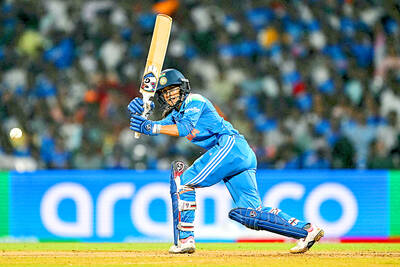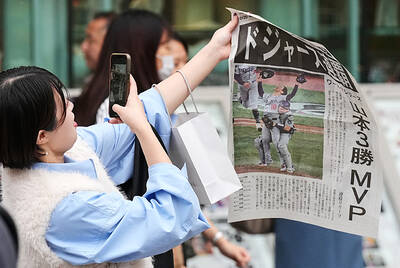"You're looking for the samurais?" said the girl sitting in the hallway. "They're up there."
She pointed up a staircase to a small gym on the top floor of Jan Hus Church on East 74th Street. Inside was a startlingly surreal scene, especially to someone stepping off the streets of the Upper East Side, where people were picking up dry cleaning and lounging at sidewalk cafes on a Saturday evening.
Up in the old church gym, the scene resembled a ferocious battle from The Seven Samurai. Some 50 people in Japanese warrior dress -- dark robes, heavy chest armor and helmets with fearsome face-cages -- hurled bloodcurdling screams as they beat one another over the head with poles.

PHOTO: NY TIMES
The gym's door, though closed, hardly stifled the screams or contained the thunderous stomping that rumbled the building itself. Even residents of neighboring high-rises have grown accustomed to the boisterous practices held three evenings a week by the New York City Kendo Club, a tight-knit group of urban samurais who have made this gym their home dojo for a quarter-century.
The club was founded in 1976 by Noboru Kataoka, a world-renowned kendo sensei. To honor its 30th anniversary, the club is holding a kendo tournament on Sunday at John Jay College of Criminal Justice on the West Side, where kendo practitioners from around the world will compete.
Kataoka's students tend to follow his teachings religiously. Whatever their profession -- sanitation men battle architects, lawyers fight film producers and teachers face off with editors -- they say the ancient principles of the samurai warrior help them cut through the complexities of the modern urban environment.

PHOTO: NY TIMES
There is the money manager who credits kendo with keeping him sharp when making crucial investment decisions. There is the architect who says kendo enables him to handle high-pressure projects and harrowing deadlines. There is the Brooklyn woman who sleeps with her kendo sword next to her bed for security.
"From the moment you set foot in this dojo, you are a New York samurai," said Jose Pena, 51, who has been studying with Kataoka three days a week for the past 27 years. "It may be 2006, but we still follow the way of the warrior."
Pena studies Japanese culture and travels regularly to Japan to take advancement tests in the kendo rankings known as dans. He is currently in the sixth dan and is already looking forward to returning in 2011 for the test to enter the seventh dan, the second-highest rank.
The money manager, Raymond Stewart, said he joined kendo 25 years ago to help him handle his stressful finance job on Wall Street.
"I manage more than US$200 million and have to make the right decision about what to do with it," he said. "Kendo teaches you to wait for the right moment and then strike with total conviction."
The club's members competing on Sunday are entered under smaller teams with names such as the Spare Ribs, the Wild Bunch and Cutie Honey.
One member of Cutie Honey is Kyung Kim, 33, a teacher from Queens who joined the club three years ago after seeing kendo only occasionally on Korean soap operas.
"I'm very sensitive emotionally, and I needed mental discipline in my life," she said at David Copperfield's pub, where the club gathers with Kataoka for drinks after class.
When Kataoka first came to New York from Japan, he began renting teaching space in various dance studios downtown, but found them too flimsy for kendo practice. Three broken wooden floors and one shattered wall mirror later, he found Jan Hus church. Its floor was strong, but its neighbors were unaccustomed to the screaming and commotion of kendo. Several times, police officers were called to the gym.
"They would come busting in the door, and then stop and look and say, `Oh, kendo,"' he said. Yelling is a crucial part of kendo, he explained, a sign that the stomach and chest muscles are joining in the power of the strike.
"This where the strength comes from," he said, holding his belly. "We yell to bring the power up from here. The more years you train, the better you can yell. It's like an opera singer."
At practice last week, each newcomer suited up methodically in dark robes. Each donned a chest plate and wrapped his head in a bandanna emblazoned with Japanese characters depicting various aspects of kendo. Then the helmet, its wire face mask menacing and its epaulet flaps flaring out like the Flying Nun's habit, to protect the shoulders.
Kendo is done in bare feet and the footwork is short, choppy and quick. Each student uses a bamboo-slatted staff known as a shinai. The students line up to spar with the senior members of the class. The players meet and cautiously cross the tips of their swords and begin parrying for the smallest of openings through which to strike. Then they rush at each other with a powerful gallop, holding their swords above their head with both hands and striking down.
Kataoka demonstrated how to push the opponent's sword, causing the opponent to push back and thus create an imbalance: an opening.
"If you don't have technique, all you have left is power, muscle," said Kataoka, 57, who teaches with grace and an economy of words and movement. He also gets occasional work as an actor under the name Ken Kensei, including a part in an upcoming film directed by Clint Eastwood, Red Sun, Black Sand.
His wife, Mami Kataoka, 42, was also at practice. She has been practicing kendo since age 11 and has reached the fourth dan. She had just flown in from Japan, and after weeks of separation, the spouses reunited not by embracing, but by exchanging blows to the head and shoulders.
After practice, Kataoka took out a steel sword and knelt down next to it, to demonstrate a 400-year-old art of drawing the sword, known as iaido. Kataoka is a 20th-generation master of the form, having studied it since childhood with a premier sensei in Japan.
His eyes almost closed, he went through a routine of highly stylized movements, repeatedly sheathing and unsheathing the sword. It whistled through air as it sliced through imaginary opponents in some ancient battle.
Then he put on his Angels jacket and walked out into the quiet night of East 74th Street.

Jemimah Rodrigues on Thursday hit an unbeaten 127 as India pulled off a record chase of 339 against Australia to set up a Women’s World Cup final against South Africa. Rodrigues and skipper Harmanpreet Kaur, who hit 89, put on 167 runs for the third wicket as India won with nine balls and five wickets to spare at DY Patil Stadium, on the outskirts of Mumbai. The hosts finished on a total of 341-5 in reply to Australia’s impressive 338 and ensured there would be a new name on the 50-over trophy tomorrow. Amanjot Kaur hit the winning boundary to trigger wild celebrations

Jannik Sinner on Thursday eased past Francisco Cerundolo 7-5, 6-1 at the Paris Masters to set up a quarter-final clash with Ben Shelton, while reigning champion Alexander Zverev earned a straight-sets win over Alejandro Davidovich Fokina in the third round. A maiden crown in the French capital would return Sinner to No. 1 in the world rankings after current incumbent Carlos Alcaraz suffered a shock early exit at the hands of Britain’s Cameron Norrie. The Italian four-time Grand Slam champion is yet to drop a set in the tournament as he hones in on what would be a fifth title of the

‘BLOWN AWAY’: With 12 strikeouts and no walks, Yesavage broke the World Series record of 11 strikeouts set by the Brooklyn Dodgers’ Don Newcombe in 1949 Trey Yesavage on Wednesday night soaked in Dodger Stadium, filled with 52,175 fans about to watch him pitch in the MLB World Series, and thought back to starting his season in front of 327 spectators in the low minor leagues. A sandlot story worthy of a movie studio back lot. “Crazy world,” the wide-eyed Toronto Blue Jays pitcher said. “Hollywood couldn’t have made it this good.” Just 46 days after rocketing to his fifth level of professional baseball this season for his major league debut, Yesavage pitched one of the best games by a rookie in World Series history. He set a Fall Classic

Yesterday morning in Japan began with a palpable buzz after the Los Angeles Dodgers announced Shohei Ohtani would start Game 7 of the World Series. By the time countryman Yoshinobu Yamamoto delivered the final out, Tokyo was erupting with joy. “I am so proud today to be Japanese,” said cab driver Seiichiro Okada, who pulled his car to the side of the road to watch the ending. “To be able to watch these legends in real time is something else.” Ohtani had two hits and also pitched, while Yamamoto earned World Series Most Valuable Player after yet another stellar pitching performance as the